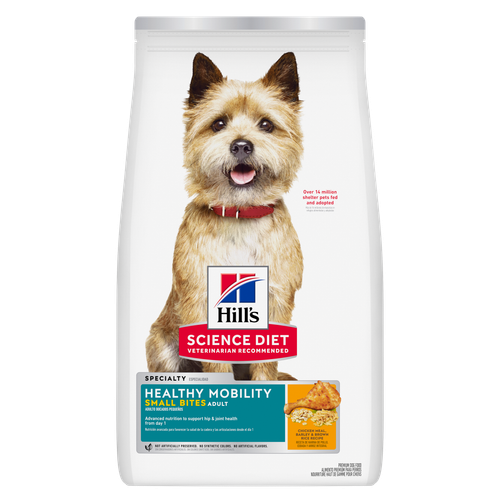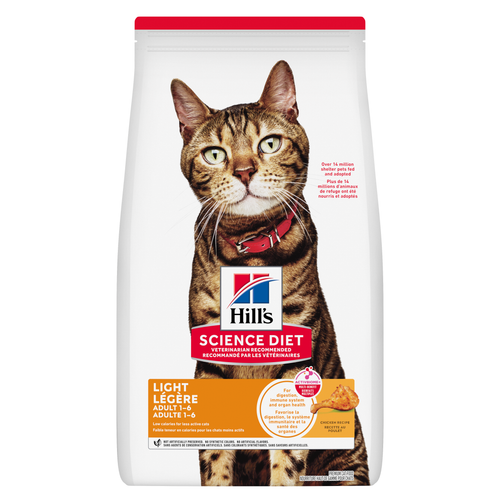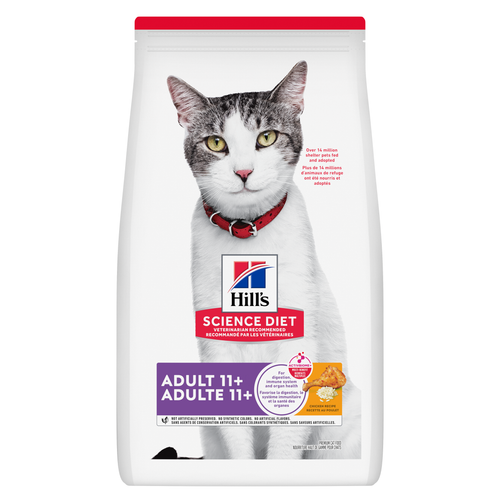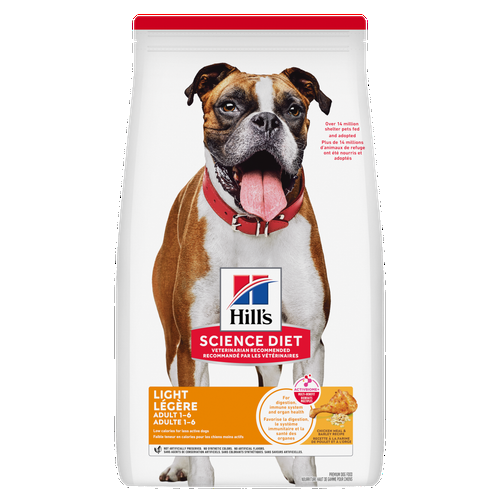
-
Find the right food for your petTake this quiz to see which food may be the best for your furry friend.Find the right food for your petTake this quiz to see which food may be the best for your furry friend.Featured products
 Adult Healthy Mobility Small Bites Chicken Meal, Barley & Brown Rice Recipe Dog Food
Adult Healthy Mobility Small Bites Chicken Meal, Barley & Brown Rice Recipe Dog FoodAdvanced nutrition to support hip & joint health from day 1
Shop Now Adult Sensitive Stomach & Skin Small & Mini Chicken Recipe Dog Food
Adult Sensitive Stomach & Skin Small & Mini Chicken Recipe Dog FoodHill's Science Diet Sensitive Stomach & Skin Small & Mini dry dog food is tailored nutrition for Small & Mini dogs while being gentle on stomachs. Nourishes skin & promotes a lustrous coat.
Shop Now Adult Light Large Breed Chicken Meal & Barley Recipe Dog Food
Adult Light Large Breed Chicken Meal & Barley Recipe Dog Food18% lower calories vs. Science Diet Large Breed Adult
Shop NowFeatured products Adult Healthy Cuisine Seared Tuna & Carrot Medley Cat Food
Adult Healthy Cuisine Seared Tuna & Carrot Medley Cat FoodDelicious seared tuna paired with tender carrots in a mouthwatering sauce
Shop Now Adult Light Chicken Recipe Cat Food
Adult Light Chicken Recipe Cat Food20% lower calories vs. Hill's Science Diet Adult
Shop Now Adult 11+ Chicken Recipe Cat Food
Adult 11+ Chicken Recipe Cat FoodSupports brain health & beautiful fur. Helps keep immune system, heart & kidneys healthy.
Shop Now -
Dog
- Dog Tips & Articles
-
Health Category
- Weight
- Food & Environmental Sensitivities
- Urinary
- Digestive
- Joint
- Kidney
- Dental
- Cancer
-
Life Stage
- Puppy Nutrition
- Adult Nutrition
- Senior Nutrition
Cat- Cat Tips & Articles
-
Health Category
- Weight
- Skin & Food Sensitivities
- Urinary
- Digestive
- Kidney
- Dental
- Stress
- Cancer
-
Life Stage
- Kitten Nutrition
- Adult Nutrition
Featured articles Importance of DHA in your Pet's Food
Importance of DHA in your Pet's FoodLearn about DHA, Docosahexaenoic Acid, a natural omega-3 fatty acid that is essential in the development of the brain and nervous system in cats & dogs.
Read More Water
WaterDiscover why water is the most important nutrient for your dog or cat to live a healthy life. Find out how much water your pet should consume each day.
Read More Antioxidants
AntioxidantsUnderstand the importance of antioxidants in your dog or cat's food, and how they can help protect your pet and keep them healthy.
Read More -


 Dogs are classified as members of the family Canidae and the order Carnivora, but this does not necessarily translate to behavior, anatomy or feeding preferences.
Dogs are classified as members of the family Canidae and the order Carnivora, but this does not necessarily translate to behavior, anatomy or feeding preferences.
Judge for yourself
Some animals may look like carnivores or act like carnivores. But, are they really true carnivores? You be the judge.
- Wolves attack plant-eating animals, but one of the first parts they consume is the stomach contents and the viscera of those animals.1
- Coyotes eat a variety of foodstuffs including small mammals, amphibians, birds, fruits and herbivore feces.
- Panda bears are also members of the order Carnivora, but they are herbivores who primarily consume bamboo leaves.
The acid test
Key points
- The term "opportunivore" may best describe the dog's natural desire to eat whatever is available — plants as well as animals.
Strict or true carnivores, such as cats, have a higher nutritional requirement for taurine (an amino acid), arachidonic acid (a fatty acid), and certain vitamins (niacin, pyridoxine, vitamin A), which are readily available in animal protein and fat sources.
Omnivores, such as dogs and people, don't have higher requirements for taurine and certain vitamins and can create their own arachidonic acid from vegetable oils.


Tasty Tips
Omnivore qualities
There are other nutritional, behavioral and physical factors that separate the omnivore and carnivore worlds:
- Dogs have teeth (molars) with relatively flat surfaces designed to grind up bones as well as fibrous plant material.
- Dogs can digest almost 100% of the carbohydrates they consume.2
- Dogs have a small intestine that occupies about 23 percent of the total gastrointestinal volume, which is consistent with other omnivores; the small intestine of cats occupies only 15 percent.3,4
- Dogs can create vitamin A from betacarotene found in plants.
Confusion in their conclusion
Some folks have come to the erroneous conclusion that dogs must be carnivores because they fall under the order Carnivora. A close look at the anatomy, behavior and feeding preferences of dogs shows that they are actually omnivorous — able to eat and remain healthy with both animal and plant foodstuffs.
1 Lewis L, Morris M, Hand M. Small Animal Clinical Nutrition, Ed. 4. Topeka, KS, Mark Morris Institute, 2000;294-303,216-219.
2 Walker J, Harmon D, Gross K, Collings G. Evaluation of nutrient utilization in the canine using the ileal cannulation technique. J Nutr. 1994; 124:2672S-2676S.
3 Morris JG, Rogers QR. Comparative aspects of nutrition and metabolism of dogs and cats, in: Nutrition of the dog and cat, eds. Burger IH, Rivers JPW, Cambridge, UK, Cambridge University Press, 1989;35-66.
4 Ruckebusch Y, Phaneuf L-Ph, Dunlop R. Feeding behavior in: Physiology of small and large animals, B.C. Decker, Inc. Philadelphia, PA, 1991;209-219.


One of our staff authors prepared this article for you
Related products

Hill's Science Diet Sensitive Stomach & Skin Small & Mini dry dog food is tailored nutrition for Small & Mini dogs while being gentle on stomachs. Nourishes skin & promotes a lustrous coat.

Advanced nutrition to support hip & joint health from day 1

18% lower calories vs. Science Diet Adult

18% lower calories vs. Science Diet Large Breed Adult
Related articles

Learn basic steps & precautions for treating a cut on your dog, including what you can put on the cut, and when you should take them to the vet.

Your dog's coat and skin are a big part of your dog's overall health. Ensure you keep your dog's coat healthy, by following these simple tips.

Learn how dogs with sensitive skin can have special dietary needs, how they can develop over time in a healthy dog, and how Hill's dog food can help.

Discover how the field of dog science is giving us more and more insights into the inner workings of our furry best friends.

Put your dog on a diet without them knowing
Our low calorie formula helps you control your dog's weight. It's packed with high-quality protein for building lean muscles, and made with purposeful ingredients for a flavorful, nutritious meal. Clinically proven antioxidants, Vitamin C+E, help promote a healthy immune system.
Put your dog on a diet without them knowing
Our low calorie formula helps you control your dog's weight. It's packed with high-quality protein for building lean muscles, and made with purposeful ingredients for a flavorful, nutritious meal. Clinically proven antioxidants, Vitamin C+E, help promote a healthy immune system.

